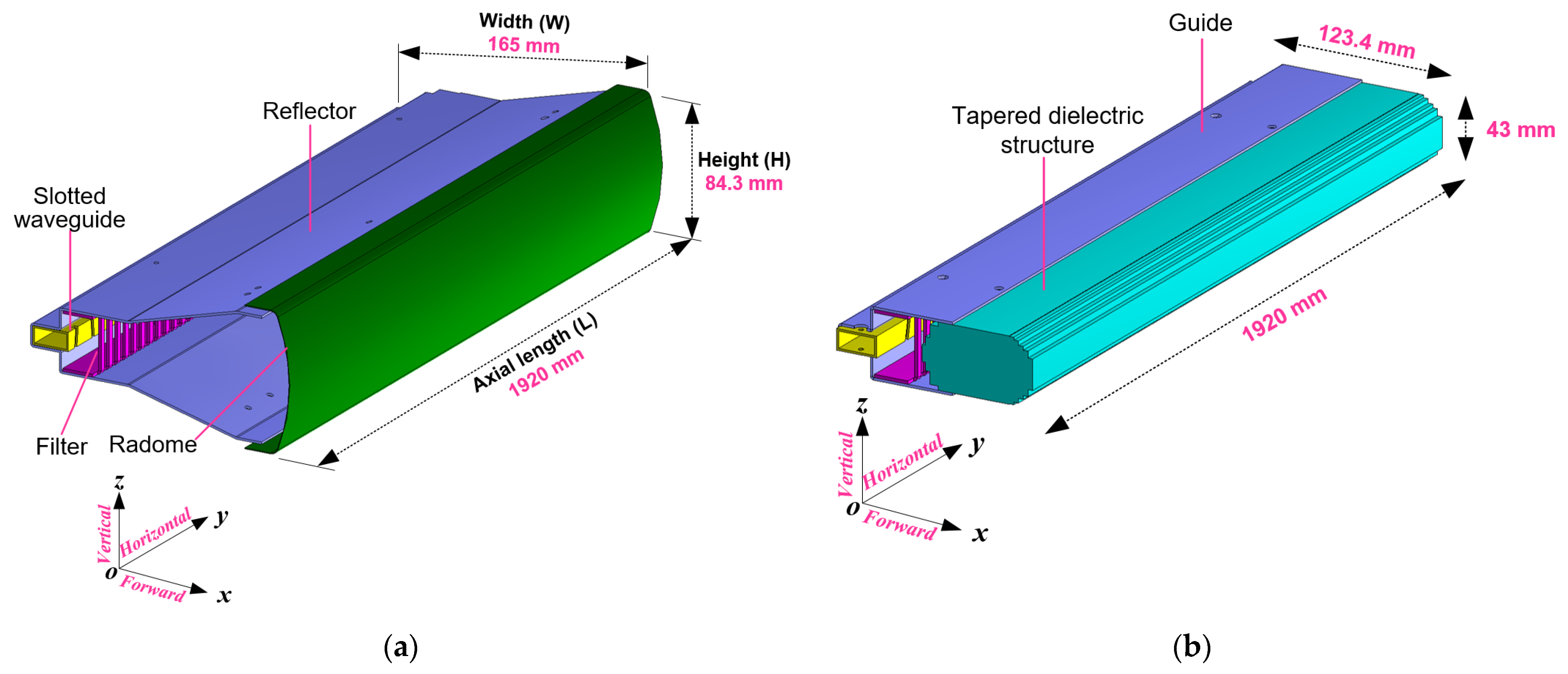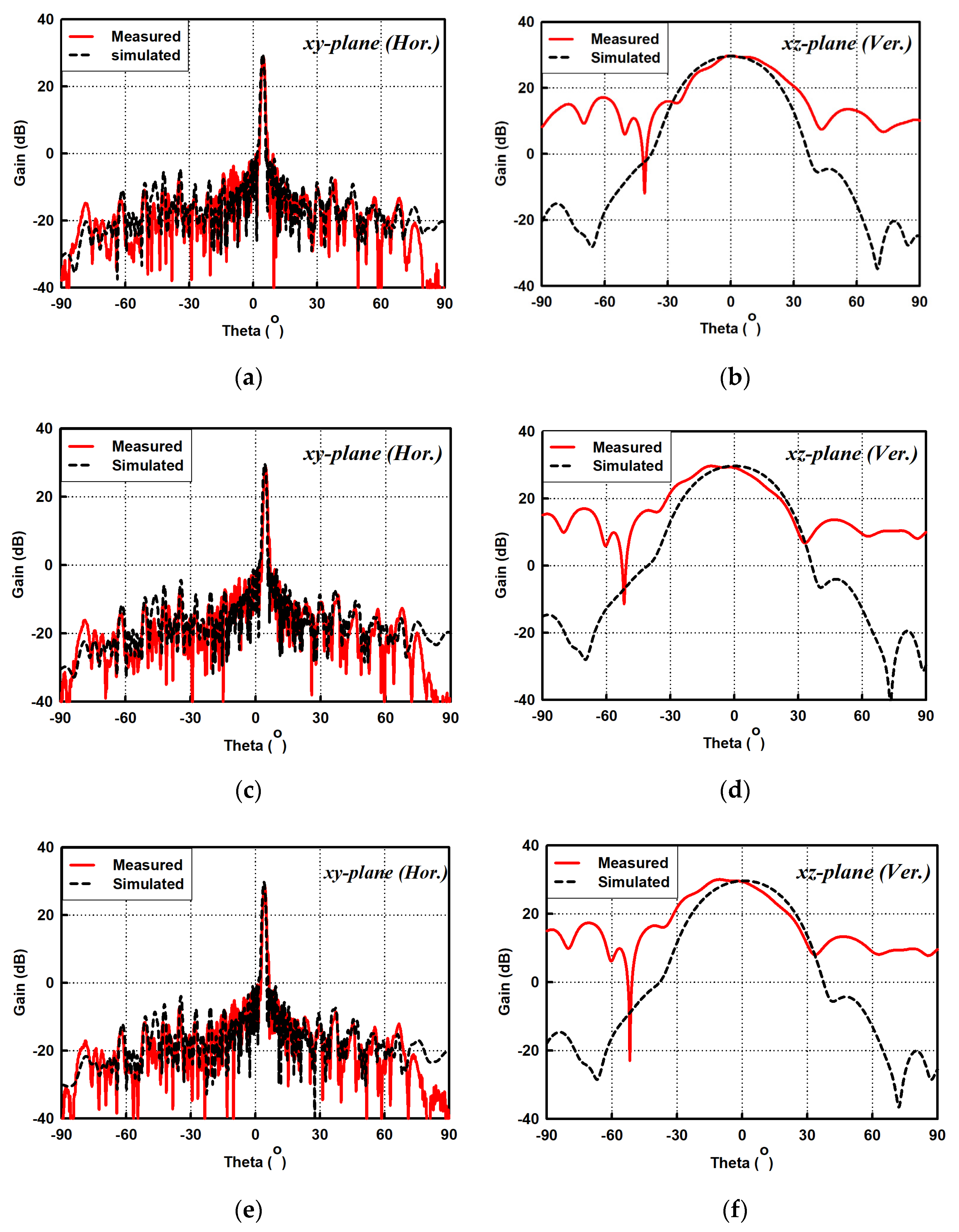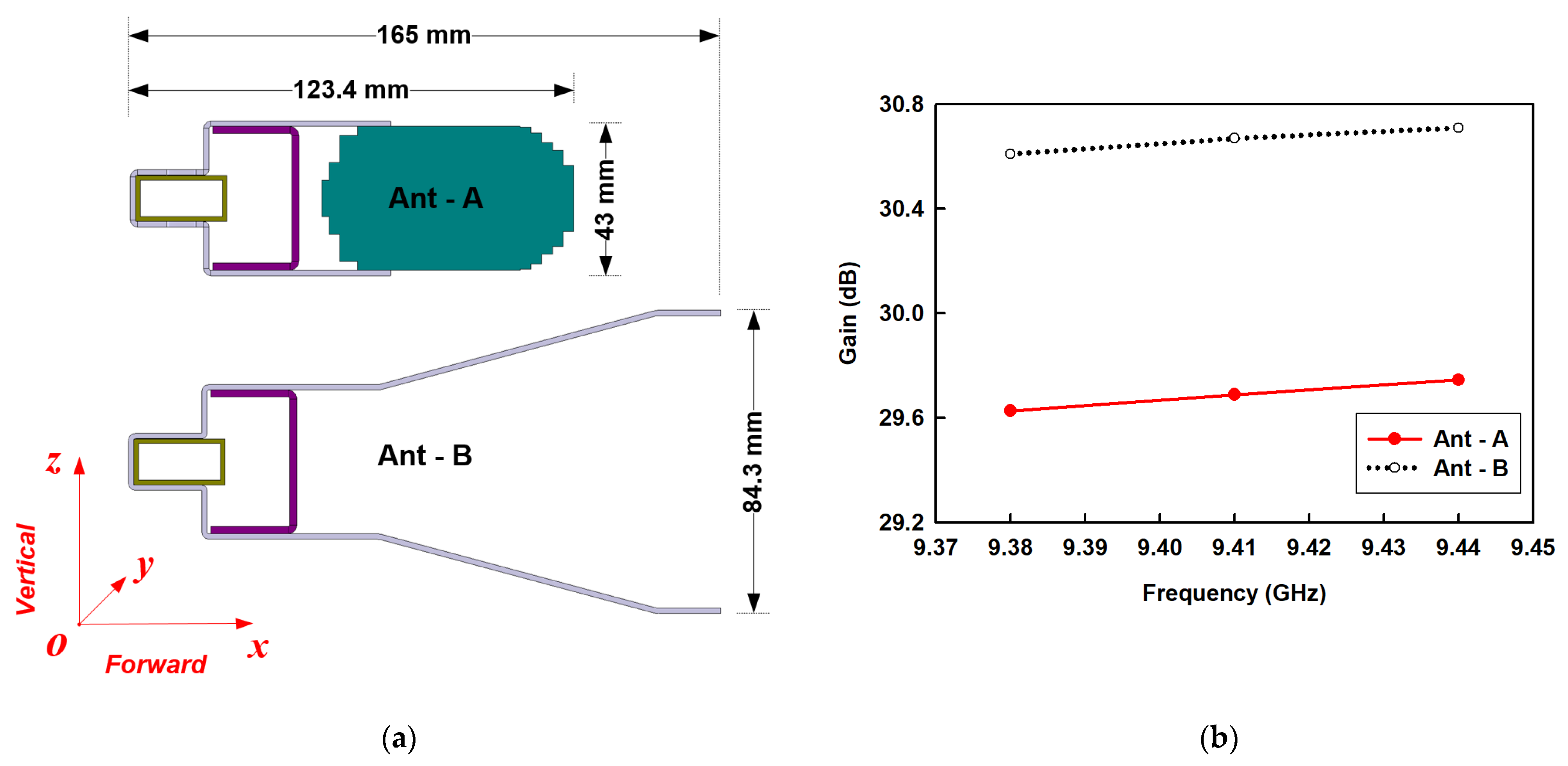Compact Slotted Waveguide Antenna Array Using Staircase Model of Tapered Dielectric-Inset Guide for Shipboard Marine Radar
Abstract
:1. Introduction
2. Antenna Configuration
2.1. Slotted Waveguide Design
2.2. Polarization Filter
2.3. Reflector
3. Design and Analysis of the Proposed Slotted Waveguide Array Antenna
3.1. Evolution of the Proposed Case
3.2. End Gradient Optimization
3.3. Dielectric Material Selection
4. Results and Discussion
- Ant-A: Proposed SWA array comprising of a slotted waveguide, compact dielectric structure, and miniaturized reflector.
- Ant-B: Commercial SWA array composed of a slotted waveguide and a relatively larger reflector.
5. Conclusions
Author Contributions
Funding
Institutional Review Board Statement
Informed Consent Statement
Data Availability Statement
Conflicts of Interest
References
- Da Costa, I.F.; Spadoti, D.H.; Cerqueira, S.A. Dual-band slotted waveguide antenna array for communication, maritime navigation and surveillance radar. In Proceedings of the 2015 International Workshop on Telecommunications (IWT), Santa Rita do Sapucai, Brazil, 14–17 June 2015. [Google Scholar]
- Maa, J.P.-Y.; Ha, H.K. X-Band Radar Wave Observation System. Available online: http://139.70.23.12/people/maa_jp/pubs/X-band%20radar%20wave%20Observation%20system.pdf (accessed on 11 July 2021).
- Wang, H.; Hu, H.; Chung, S. High gain slot-pair substrate-integrated-waveguide antenna for 77 GHz vehicle collision warning radar. In Proceedings of the 2014 11th European Radar Conference, Rome, Italy, 6–9 October 2014. [Google Scholar]
- Dolan, B.A.; Ruthledge, S.A. An Integrated Display and Analysis Methodology for Multivariable Radar Data. J. Appl. Meteorol. Climatol. 2007, 46, 1196–1213. [Google Scholar] [CrossRef] [Green Version]
- Mirzaei, G.; Jamali, M.M.; Ross, J.; Gorsevski, P.V.; Bingman, V.P. Data fusion of acoustics, infrared, and marine radar for avian study. IEEE Sens. J. 2015, 15, 6625–6632. [Google Scholar] [CrossRef]
- Young, R.; Rosenthal, W.; Ziemer, F. A three-dimensional analysis of marine radar images for the determination of ocean wave directionality and surface currents. J. Geophys. Res. 1985, 90, 1049–1059. [Google Scholar] [CrossRef] [Green Version]
- Jung, Y.-B.; Yeom, I.; Jung, C.W. Centre-fed series array antenna for k-/ka-band electromagnetic sensors. IET Microw. Antennas Propag. 2012, 6, 588–593. [Google Scholar] [CrossRef]
- Hajian, M.; Zijderveld, J.; Lestari, A.A.; Ligthart, L.P. Analysis, design and measurement of a series-fed microstrip array antenna for X-band INDRA: The Indonesian maritime radar. In Proceedings of the 3rd European Conference on Antennas and Propagation, Berlin, Germany, 23–27 March 2009; pp. 1154–1157. [Google Scholar]
- Huque, T.; Hossain, K.; Islam, S.; Chowdhury, A. Design and performance analysis of microstrip array antennas with optimum parameters for X-band applications. Int. J. Adv. Comput. Sci. Applicat. 2011, 2, 81–87. [Google Scholar]
- Hautcoeur, J.; Cruz, E.M.; Bartholomew, J.; Sarrazin, J.; Mahe, Y.; Toutain, S. Low-cost printed antenna array built with hybrid feed for urban microwave links. IET Microw. Antennas Propag. 2010, 4, 1320–1326. [Google Scholar] [CrossRef]
- Iizuka, H.; Sakakibara, K.; Watanabe, T.; Sato, K.; Nishikawa, K. Millimeter-wave microstrip array antenna with high efficiency for automotive radar systems. R&D Rev. Toyota CRDL 2002, 37, 7–12. [Google Scholar]
- Barba, M. A high-isolation, wideband and dual-linear polarization patch antenna. IEEE Trans. Antennas Propag. 2008, 56, 1472–1476. [Google Scholar] [CrossRef] [Green Version]
- Lee, B.; Kwon, S.; Choi, J. Polarisation diversity microstrip base station antenna at 2 GHz using t-shaped aperture-coupled feeds. IEE Proc. Microw. Antennas Propag. 2001, 148, 334–338. [Google Scholar] [CrossRef]
- Li, B.; Yin, Y.-Z.; Hu, W.; Ding, Y.; Zhao, Y. Wideband dual-polarized patch antenna with low cross polarization and high isolation. IEEE Antennas Wirel. Propag. Lett. 2012, 11, 427–430. [Google Scholar]
- Bayderkhani, R.; Hassani, H.R. Wideband and low sidelobe slot antenna fed by series-fed printed array. IEEE Trans. Antennas Propag. 2010, 58, 3898–3904. [Google Scholar] [CrossRef]
- Levine, E.; Malamud, G.; Shtrikman, S.; Treves, D. A study of microstrip array antennas with the feed network. IEEE Trans. Antennas Propag. 1989, 37, 426–434. [Google Scholar] [CrossRef]
- Huang, J. A Ka-band circularly polarized high-gain microstrip array. In Proceedings of the IEEE Antennas and Propagation Society International Symposium and URSI National Radio Science Meeting, Seattle, WA, USA, 20–24 June 1994. [Google Scholar]
- James, J.R.; Hall, P.S.; Wood, C. Microstrip Antenna Theory and Design; Peter Peregrinus: London, UK, 1981. [Google Scholar]
- Mailloux, R.; McIlvenna, J.; Kernweis, N. Microstrip array technology. IEEE Trans. Antennas Propag. 1981, 29, 25–37. [Google Scholar] [CrossRef]
- Weiss, M. Microstrip antennas for millimeter waves. IEEE Trans. Antennas Propag. 1981, 29, 171–174. [Google Scholar] [CrossRef]
- Rengarajan, S.R. Advances in Slotted Waveguide Array Antenna Technology. In Proceedings of the 2019 IEEE International Conference on Microwaves, Antennas, Communications and Electronic Systems (COMCAS), Tel-Aviv, Israel, 4–6 November 2019. [Google Scholar]
- Coetzee, J.C.; Sheel, S. Waveguide Slot Array Design WITH Compensation for Higher Order Mode Coupling Between Inclined Coupling Slots and Neighboring Radiating Slots. IEEE Trans. Antennas Propag. 2019, 67, 378–389. [Google Scholar] [CrossRef] [Green Version]
- Misilmani, H.M.E.; Al-Husseini, M.; Kabalan, K.Y.; El-Hajj, A. A design procedure for slotted waveguide antennas with specified sidelobe levels. In Proceedings of the 2014 International Conference on High Performance Computing & Simulation (HPCS), Bologna, Italy, 21–25 July 2014; pp. 828–832. [Google Scholar]
- Pradeep, K.S.; Nagendra, N.N.; Manjunath, R.K. Design and Simulation of Slotted Waveguide Antenna Array for X-Band Radars. In Proceedings of the 2018 4th International Conference for Convergence in Technology (I2CT), Mangalore, India, 27–28 October 2018; pp. 1–6. [Google Scholar]
- Hung, K.-L.; Chou, H.-T. A design of slotted waveguide antenna array operated at X-band. In Proceedings of the 2010 IEEE International Conference on Wireless Information Technology and Systems, Honolulu, HI, USA, 28 August–3 September 2010; pp. 1–4. [Google Scholar]
- Elliott, R.S. An improved design procedure for small arrays of shunt slots. IEEE Trans. Antennas Propag. 1983, 31, 48–53. [Google Scholar] [CrossRef]
- Elliott, R.; O’Loughlin, W. The design of slot arrays including internal mutual coupling. IEEE Trans. Antennas Propag. 1986, 34, 1149–1154. [Google Scholar] [CrossRef]
- Elliott, R.S. The design of waveguide-fed slot arrays. In Antenna Handbook; Van Nostrand: New York, NY, USA, 1988. [Google Scholar]
- Yusuf, D.P.; Zulkifli, F.Y.; Rahardjo, E.T. Design of Narrow-wall Slotted Waveguide Antenna with V-shaped Metal Reflector for X-Band Radar Application. In Proceedings of the 2018 International Symposium on Antennas and Propagation (ISAP), Busan, Korea, 23–26 October 2018. [Google Scholar]
- Enjiu, R.K.; Bender, M. Slotted Waveguide Antenna Design Using 3D EM Simulation. Microw. J. 2013, 56, 72. [Google Scholar]
- Volakis, J. Antenna Engineering Handbook; McGraw-Hill Professional: New York, NY, USA, 2007. [Google Scholar]
- Balanis, C.A. Antenna Theory and Design; John Wiley & Sons, Inc.: Hoboken, NJ, USA, 1997; pp. 385–424. [Google Scholar]
- Mazur, M.; Wiśniewski, J. Performance of cross-polarization filter dedicated for slotted waveguide antenna array. In Proceedings of the 2010 IEEE Radar Conference, Arlington, VA, USA, 10–14 May 2010; pp. 1335–1338. [Google Scholar]
- Meng, R.; Zhu, Q. Design of a compact high gain end-fire dielectric rod antenna. In Proceedings of the 2016 IEEE International Symposium on Antennas and Propagation (APSURSI), Fajardo, PR, USA, 26 June–1 July 2016. [Google Scholar]












| Parameters | Value | Parameters | Value |
|---|---|---|---|
| Frequency | 9.4 GHz ± 30 MHz | Polarization | Horizontal |
| Gain | ≥28 dB | Beamwidth | Horizontal: 1.2° or less Vertical: 20° or higher |
| Voltage standing wave ratio (VSWR) | ≤1.5 | Sidelobelevel (SLL) | Horizontal: −10 dB or less Vertical: −10 dB or higher |
| Material | A | B | C | D |
|---|---|---|---|---|
| Relative permittivity () | 2.1 | 2.53 | 1.7 | 1.53 |
| Loss tangent () | 0.00015 | 0.0001 | 0.0001 | 0.00035 |
| Density () | 2.2 |
| Parameters | Requirement | Numerical Data | Measured Data | |
|---|---|---|---|---|
| Frequency | 9.4 GHz | 9.4 GHz | 9.4 GHz | ο |
| Gain | dB | dB | dB | ο |
| VSWR | ο | |||
| Polarization | Horizontal | Horizontal | Horizontal | ο |
| Beamwidth | Horizontal | ο | ||
| Vertical | ο | |||
| SLL | Horizontal dB | dB | dB | ο |
| Vertical dB | dB | dB | X |
Publisher’s Note: MDPI stays neutral with regard to jurisdictional claims in published maps and institutional affiliations. |
© 2021 by the authors. Licensee MDPI, Basel, Switzerland. This article is an open access article distributed under the terms and conditions of the Creative Commons Attribution (CC BY) license (https://creativecommons.org/licenses/by/4.0/).
Share and Cite
Anim, K.; Diawuo, H.A.; Jung, Y.-B. Compact Slotted Waveguide Antenna Array Using Staircase Model of Tapered Dielectric-Inset Guide for Shipboard Marine Radar. Sensors 2021, 21, 4745. https://doi.org/10.3390/s21144745
Anim K, Diawuo HA, Jung Y-B. Compact Slotted Waveguide Antenna Array Using Staircase Model of Tapered Dielectric-Inset Guide for Shipboard Marine Radar. Sensors. 2021; 21(14):4745. https://doi.org/10.3390/s21144745
Chicago/Turabian StyleAnim, Kyei, Henry Abu Diawuo, and Young-Bae Jung. 2021. "Compact Slotted Waveguide Antenna Array Using Staircase Model of Tapered Dielectric-Inset Guide for Shipboard Marine Radar" Sensors 21, no. 14: 4745. https://doi.org/10.3390/s21144745
APA StyleAnim, K., Diawuo, H. A., & Jung, Y.-B. (2021). Compact Slotted Waveguide Antenna Array Using Staircase Model of Tapered Dielectric-Inset Guide for Shipboard Marine Radar. Sensors, 21(14), 4745. https://doi.org/10.3390/s21144745







